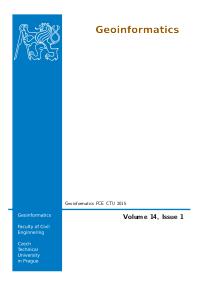Geodetic surveying as part of archaeological research in Sudan
DOI:
https://doi.org/10.14311/gi.14.1.4Keywords:
Sudan, 6th Nile cataract, surveying, KAP, methodsAbstract
Surveying is an important part of any archaeological research. In this paper we focus on the archaeological research in north Sudan (6th Nile cataract) and the surveying methods applicable under the local conditions. Surveying in the Third World countries is affected by the political situation (limited import of surveying tools), local conditions (lack of fixed points, GNSS correction signal), inaccessible basemaps and fixed point network. This article describes the methods and results obtained during the three archaeological seasons (2011-2014). The classical surveying methods were combined with KAP (Kite Aerial Photography) to obtain the desired results in form of archaeological maps, detailed orthophoto images and other analyses results.
References
J. S. Aber, I. Marzolff, and J. B. Ries, Small-Format Aerial Photography: Principles, Techniques and Geoscience Applications. Amsterdam – London: Elsevier Science, 2010. ISBN: 978-0-444-53260-2.
A. E. Ali, “Current Status of GIS in the Sudan,” in Eighteenth United Nations Regional Cartographic Conference for Asia and the Pacific, Bangkok, United Nations E/CONF.100/CRP.10, 2009.
G. Bitelli, M. Unguendoli, and L. Vittuari, “Photographic and photogrammetric archaeological surveying by a kite system,” in Proceedings of the 3rd International Congress on Science and Technology for the Safeguard of Cultural Heritage in the Mediterranean Basin, J. A. et al, Ed. Alcala de Henares: Servicio de Publicaciones de la Universidad de Alcala, 2001, pp. 538–543.
V. Brůna, “Využití KAP (Kite Aerial Photography) při dokumentaci výzkumu v Abúsíru,” Pražské egyptologické studie, UK Praha, vol. XI, pp. 37–43, 2013.
B.-N. Chagny and A. Hesse, “Soudan 1994–2006: Photographies archéologiques sous cerf-volant avec Francis Geus,” in Mélanges offerts ? Francis Geus. Égypte-Soudan, Lille: Université Charles de Gaulle-Lille, B. Gratien, Ed. Cahiers de recherches de l’Institut de papyrologie et d’egyptologie de Lille 26, pp. 47–59.
GeoRepository, Geodetic Datum used in Africa - Eritrea, Ethiopia and Sudan. http://georepository.com/datum_6201/Adindan.html. Oct. 2015.
W. Karel, N. Pfeifer, and C. Brueser, “DTM quality assessment,” in ISPRS Technical Commission II Symposium, Vienna, W. Kainz and A. Pucher, Eds. 2006, pp. 7–12.
L. Lisá, L. Suková, V. Cílek, and P. Lisý, Sabaloka a Šestý nilský katarakt. Novela Bohemica, 2012. ISBN: 978-80-904573-6-2.
J. Pacina, K. Novák, V. Brůna, and J. Popelka, “Detailed analysis of georelief development in the lake Most surroundings,” Ad Alta: Journal of Interdisciplinary Research, vol. 3, no. 2, p. 44, 2013.
L. Suková and V. Cílek, “The Landscape and Archaeology of Jebel Sabaloka and the Sixth Nile Cataract, Sudan,” Interdisciplinaria Archaeologica – Nat. Sciences in Arch., vol. 3, no. 2, pp. 189–201, 2012.
L. Varadzín and L. Suková, “Preliminary report on the exploration of Jebel Sabaloka (West Bank), 2009-2012,” Sudan & Nubia, vol. 16, no. 1, pp. 118–131, 2012. ISSN: 1369-5770.
G. J. J. Verhoeven, J. Loenders, F. Vermeulen, and R. Docter, “Helikite aerial photography - a versatile means of unmanned, radio controlled, low-altitude aerial archaeology,” Archaeological Prospection, vol. 16, no. 2, pp. 125–138, Apr. 2009. DOI: 10.1002/arp.353.
G. Verhoeven, M. Doneus, C. Briese, and F. Vermeulen, “Mapping by matching: a computer vision-based approach to fast and accurate georeferencing of archaeological aerial photographs,” Journal of Archaeological Science, vol. 39, no. 7, pp. 2060–2070, Jul. 2012. DOI: 10.1016/j.jas.2012.02.022.
B. Żurawski, “Low altitude aerial photography in archaeological fieldwork: the case of Nubia,” Archaeologia Polona, vol. 31, pp. 243–256, 1993.
B. Żurawski, “Miracles of Banganarti. Polish archaeological discoveries in Sudan,” Focus on Archaeology, vol. 5, no. 1, pp. 20–23, 2005.
Downloads
Published
Issue
Section
License
- Authors retain copyright and grant the journal right of first publication with the work simultaneously licensed under a Creative Commons Attribution License that allows others to share the work with an acknowledgement of the work's authorship and initial publication in this journal.
- Authors are able to enter into separate, additional contractual arrangements for the non-exclusive distribution of the journal's published version of the work (e.g., post it to an institutional repository or publish it in a book), with an acknowledgement of its initial publication in this journal.
- Authors are permitted and encouraged to post their work online (e.g., in institutional repositories or on their website) prior to and during the submission process, as it can lead to productive exchanges, as well as earlier and greater citation of published work (See The Effect of Open Access).

